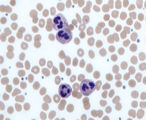Cannibal blood cells ease gout
21 May, 2013
Researchers from the Malaghan Institute of Medical Research have found that cannibalistic white blood cells, neutrophils, could be key to easing the symptoms of gout.
Gout, a type of arthritis, is a painful inflammation of joints, particularly the toes, caused by a build-up of uric acid crystals in and around the joint. The body’s immune system attacks the crystals as if they were a virus or bacteria, resulting in redness and swelling. According to the Malaghan Institute, the prevalence of gout in New Zealand is twice that observed internationally, and it is three times more common in Māori and Pacific populations. In severe cases, gout can progress from the acute form to the chronic form known as tophaceous gout, where excessive crystal build-up can cause permanent joint damage and deformity.
Potential of neutrophils to ease gout
Research by Dr Jacquie Harper and PhD student Stefanie Steiger from the Malaghan Institute, published in the March 2013 issue of the journal Arthritis & Rheumatism, shows that neutrophils have the potential to significantly ease inflammatory diseases such as gout – but only when the neutrophils start ‘eating’ each other.
Previous research has observed that some individuals who suffer from gout can quickly have their symptoms improve without treatment.
In a press release, Dr Harper said, “We believe that understanding how and why gout inflammation spontaneously resolves in some situations will enable us to more quickly and effectively treat the disease.”
Neutrophils can produce protein TGF-β1
Neutrophils are one of the first responders to uric acid crystals. However, part of the reason gout is so painful is that activated neutrophils release reactive oxygen and bleach, which cause significant cell and tissue damage in the joints that result in inflammation.
Neutrophils have long been thought to be primarily responsible for driving gout attacks, but the researchers have shown that neutrophils could also be part of a cure.
“We have known for some time that the spontaneous resolution of gout inflammation is associated with elevated levels of a protein called TGF-β1 in the synovial fluid of the affected joint,” says Dr Harper.
Dr Harper says the protein, TGF-β1, is produced by many different cells. The researchers were surprised to discover that neutrophils can produce the protein as well.
Switching off inflammation
Using a laboratory model of gout, the researchers showed that, on contact with gout crystals, neutrophils release oxygen and then die off. The dead neutrophils are then cleared by other neutrophils. This triggers the cells to produce TGF-β1, which minimises any further damage and shuts down inflammation.
“Our research has revealed a novel mechanism that contributes to the controlled resolution of gout,” says Dr Harper. “We are now exploring different ways to target neutrophil cannibalism in the joints, so we can switch off inflammation at the very early stages of a gout attack, thus minimising the pain it causes.”
Metadata
- Published:
- 21 May 2013


